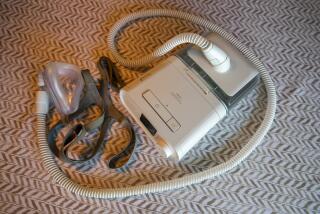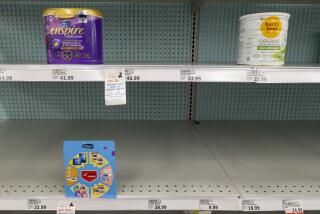Scope maker Olympus faces scrutiny over patient deaths, infections

- Share via
Three years ago, Japanese electronics giant Olympus Corp. was in crisis amid a massive accounting scandal and plunging sales of its signature cameras.
Executives vowed to save the 93-year-old firm by turning aggressively to healthcare and selling more medical scopes to doctors and hospitals in the U.S. and worldwide.
The bet paid off: Medical sales soared 25% last year, and Olympus boasts a commanding 70% share of the global market for gastrointestinal endoscopes.
But now the industry leader finds itself at the center of superbug outbreaks at U.S. hospitals, including UCLA, where two patients have died and nearly 180 more people may have been exposed to deadly bacteria on contaminated Olympus scopes.
Medical experts, health officials, lawmakers and patients’ families are pinning much of the blame for the UCLA outbreak and others across the country on the company and its intricate devices.
For its part, Olympus says it has given customers detailed cleaning instructions, and is working closely with regulators, doctors and hospitals to address any concerns about patient safety.
In recent years, Olympus had added more powerful tools at the tip of the scopes, which can cost as much as $40,000 apiece. These include extra guide wires, for instance, that can carry tiny stents and tubes to clear infections or blockages in the digestive tract.
But the extra grooves and channels added to the surface of the scope can also trap antibiotic-resistant superbugs that are difficult to remove and can be passed to other patients.
Despite those risks, the U.S. Food and Drug Administration and the specialists who use Olympus scopes say there aren’t any viable alternatives and they are too vital to do without.
“Olympus is almost like a bank that’s too big to fail now,” said hospital safety consultant Lawrence Muscarella, an expert on endoscopes who works near Olympus’ U.S. headquarters in Center Valley, Pa. “They’re brilliant, but I think they took too many risks.”
UCLA patient Antonia Torres Cerda may have paid a heavy price for that.
The 48-year-old liver transplant patient and mother of four daughters died Nov. 8 at UCLA after becoming infected from a contaminated Olympus scope, according to a lawsuit her family filed last week against the company.
Her 18-year-old daughter, Cynthia, said her mother was feeling better after the transplant when suddenly the infection hit and there were no antibiotics to stop it. Her family lives in the Central Valley town of Corcoran, where her father, Armando, is a farmworker.
“It was irresponsible of the company to have equipment contaminated with bacteria that killed people,” said Cynthia, a freshman at UC Santa Cruz. “I have a little sister who is 7 years old. Our mom is gone.”
The deadly outbreaks came after years of red flags. And government officials now concede the problem may be even worse because many scope-related infections have gone undetected or unreported.
Since 2007, ECRI Institute, a nonprofit group that evaluates medical devices for hospitals and other organizations, has listed the risk of contaminated endoscopes and other surgical instruments among its top 10 health hazards.
In 2008, the U.S. Centers for Disease Control and Prevention urged that endoscopes be redesigned so they don’t represent a “potential source of infectious agents.”
Last year, the Joint Commission, which accredits and inspects hospitals, raised alarms about tainted endoscopes and other equipment posing an immediate threat to patients’ lives.
The FDA said it has received 75 reports of contaminated scopes causing possible infections in 135 patients who underwent endoscopic retrograde cholangiopancreatography, or ERCP, from January 2013 to December 2014.
“These infections and complications from ERCP have been widely known for a long time and widely ignored,” said Helen Haskell, founder of Mothers Against Medical Error in Columbia, S.C. Her son Lewis died in 2000 after undergoing a minimally invasive surgery.
“This should have been taken care of years ago,” she said.
Many of these same concerns also apply to Olympus’ two main rivals, Pentax Medical and Fujifilm.
But market leader Olympus has drawn the most scrutiny because its scopes have been implicated in some of the biggest outbreaks.
The company said it has told customers its TJF-Q180V scope “requires careful attention to cleaning and reprocessing steps, including meticulous manual cleaning.”
In an alert to customers after the UCLA outbreak became public, Olympus said it was aware of 95 complaints about that duodenoscope related to patient infections.
As the outbreaks continued to unfold, Olympus executives have made presentations to medical professionals emphasizing that infections from reusable scopes are rare if cleaning instructions are followed.
The company’s manager of infection control was a featured speaker at a conference in Las Vegas the week before news broke about the UCLA infections. Her topic: “How to Avoid Superbugs and Lawsuits in Your GI Lab.”
“Endoscopes reprocessed appropriately pose virtually no risk of patient-borne or environmental organisms,” Mary Ann Drosnock, manager of infection control for Olympus America, told the gathered healthcare professionals.
Some have suggested that hospitals must bear some of the blame for not adequately cleaning these reusable devices.
But CDC officials and other public health departments say they have generally found that hospitals involved in outbreaks were following the manufacturers’ cleaning directions.
Likewise, Dr. William Maisel, a top scientist at the FDA, warned last week that “the complex design of duodenoscopes may impede effective cleaning.” He said the agency is working with manufacturers on alternative cleaning protocols and other steps to reduce infections.
The overall rate of infection remains low compared with the roughly 500,000 ERCP procedures done annually.
But Chris Lavanchy, ECRI’s engineering director, said the consequences of failing to remove dangerous germs can be severe.
The carbapenem-resistant Enterobacteriaceae superbug that was shared on the scopes at UCLA and in other outbreaks can be fatal in up to 50% of patients who become infected.
“I think a lot of people are leaning toward wanting a redesign,” Lavanchy said. “But my guess is it will take some time.”
In April 2012, Olympus put a new focus on its medical business to overcome the ongoing fallout from a $1.7-billion accounting scandal.
Company executives were particularly bullish on their prospects in the U.S. with the Affordable Care Act set to expand health coverage to millions of Americans.
In North America, its sales of endoscopes and other medical products shot up 28% for the year that ended March 31.
“Two years ago, Olympus was in a state of crisis,” Hiroyuki Sasa, the company’s president, said in the 2014 Olympus annual report. He hailed the medical business for a “record-breaking performance.”
One key part of that success has been the company’s close ties to doctors, industry analysts say.
Olympus is a major donor to the American Society for Gastrointestinal Endoscopy. The company also contributed more than $1 million to the society’s new Institute for Training and Technology.
Dr. Colleen Schmitt, the society’s president and a Chattanooga, Tenn., physician, said contributions from Olympus and other companies don’t pose a conflict of interest.
“It’s in the best interest of both patients and our membership that we work with partners no matter what device or medication they bring to the table,” she said.
The company’s relationship with medical providers has already come under scrutiny. Last month, Olympus said federal investigators are looking into whether it violated laws that ban improper kickbacks to doctors and other customers. The company said it’s working to resolve the matter.
Absent newly designed scopes and lacking much federal guidance, hospitals have been scrambling to shore up their cleaning methods.
In some cases, that’s generated more business for Olympus.
As hospitals quarantine their scopes after cleaning to check for any bacterial growth, that has created a need to buy more scopes to compensate for the lack of available instruments.
In Seattle, Virginia Mason Medical Center bought 20 additional scopes.
Dr. Andrew Ross, the hospital’s section chief of gastroenterology, said placing such a big order with Olympus “certainly seemed ironic from our perspective.”
Twitter: @chadterhune
Twitter: @melodypetersen
Times staff writer Soumya Karlamangla contributed to this report.
More to Read
Inside the business of entertainment
The Wide Shot brings you news, analysis and insights on everything from streaming wars to production — and what it all means for the future.
You may occasionally receive promotional content from the Los Angeles Times.











